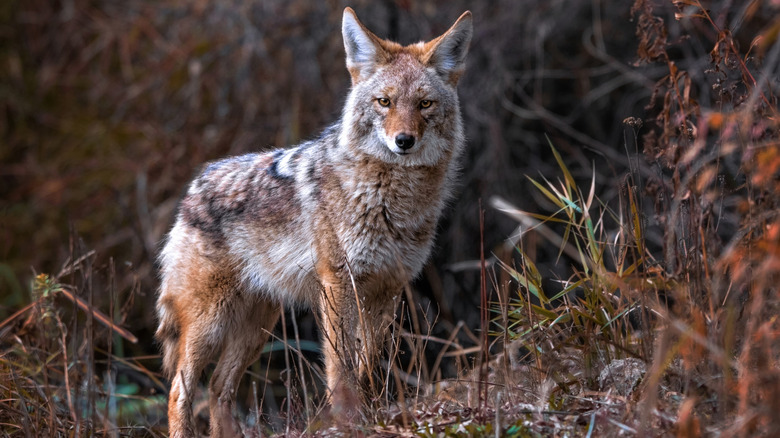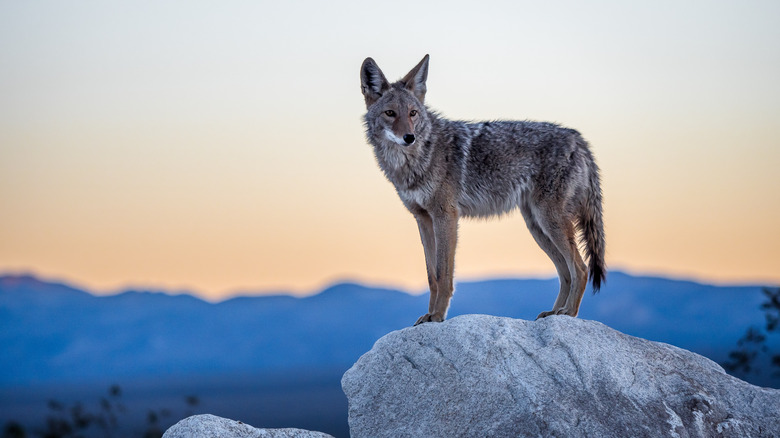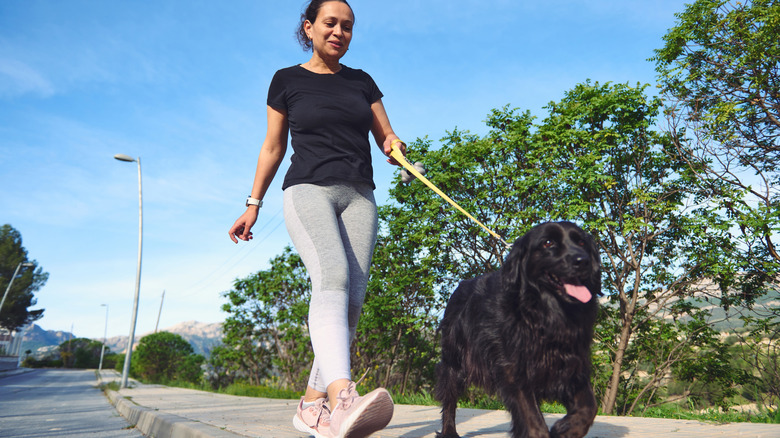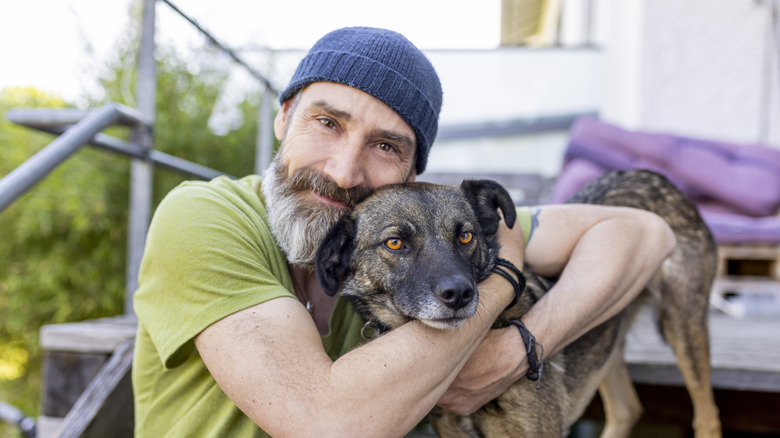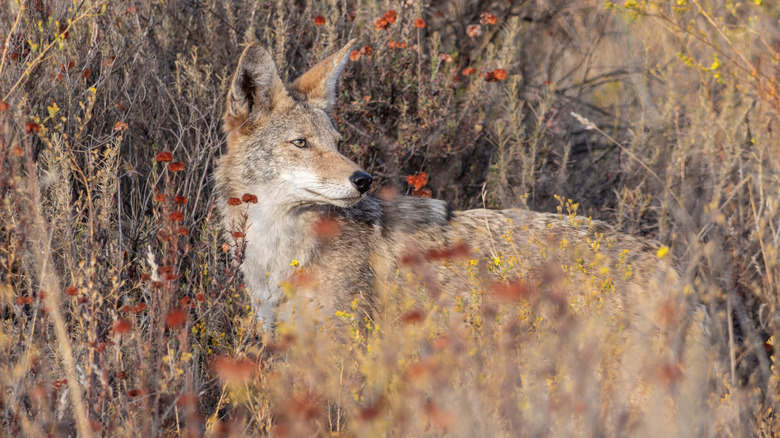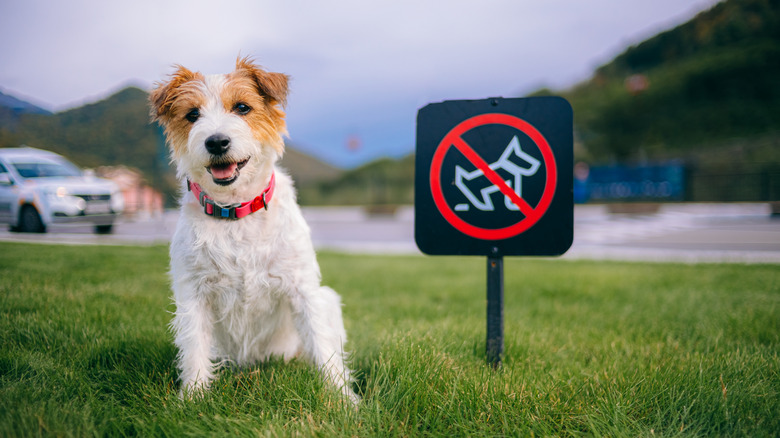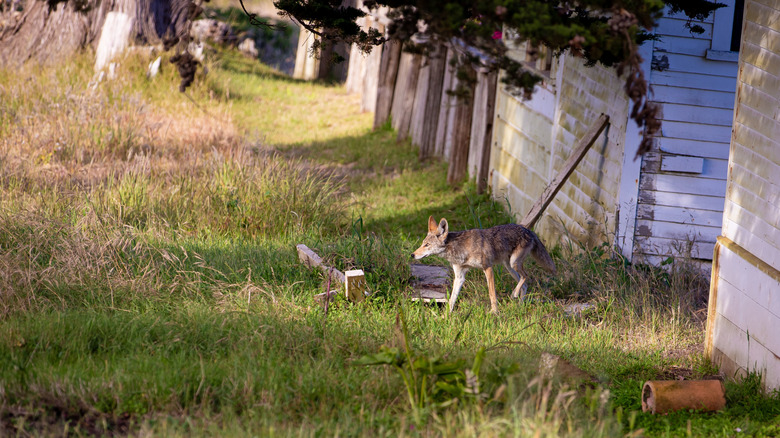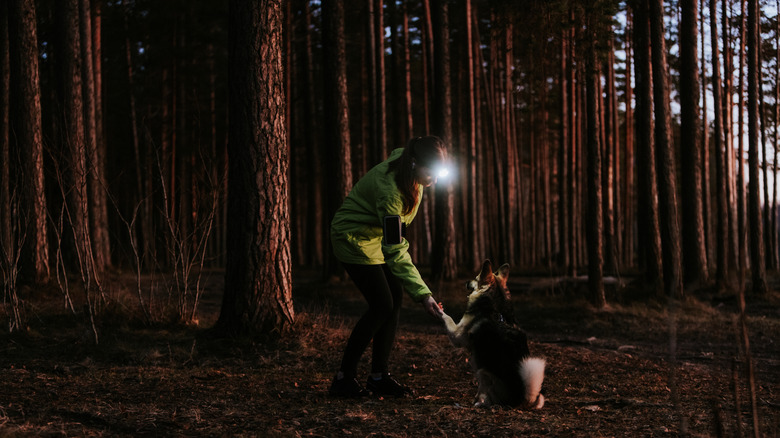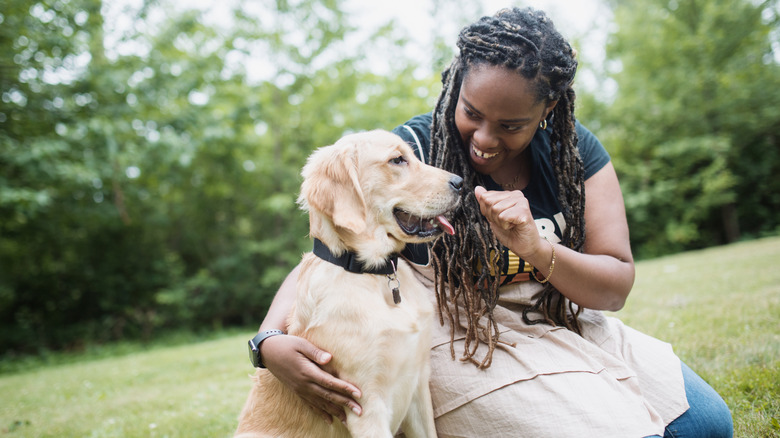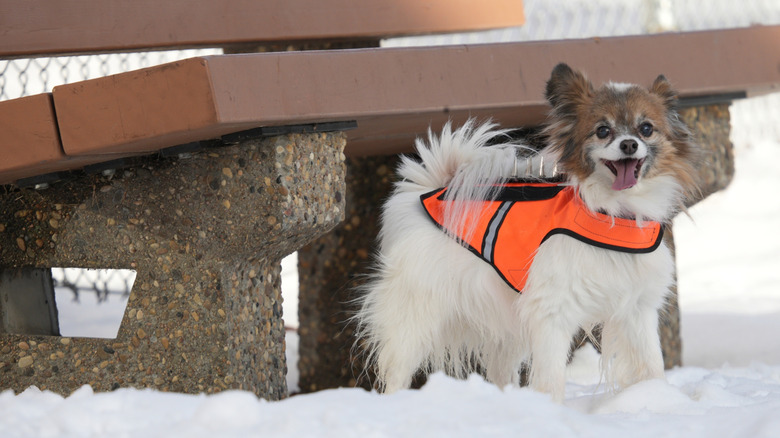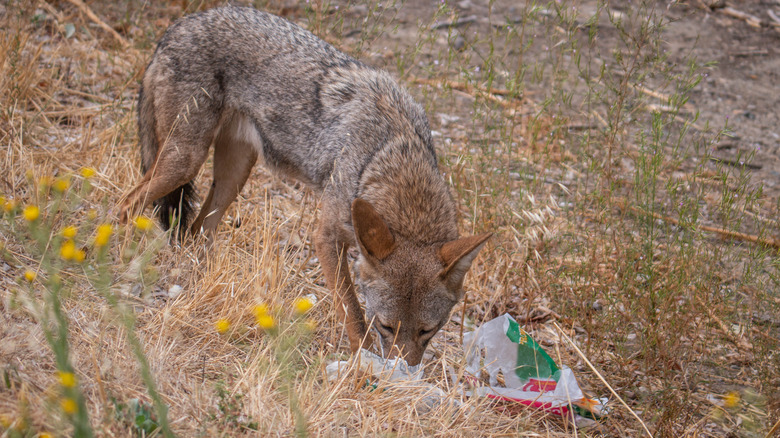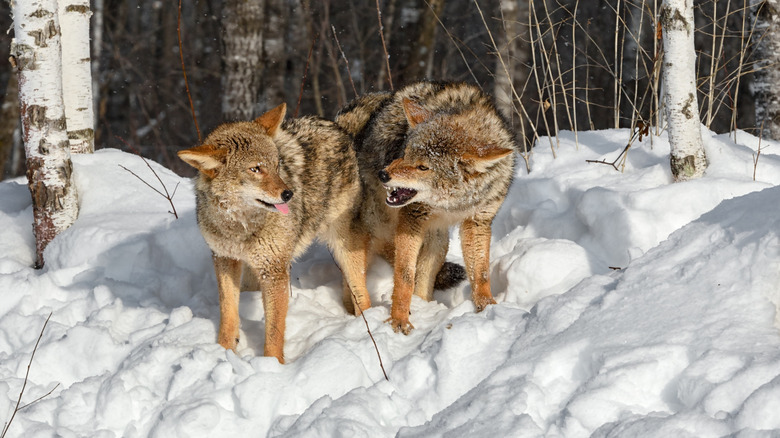11 Ways To Keep Your Dog Safe From The Dangers Posed By Coyotes
We may receive a commission on purchases made from links.
There's a reason Wile E. Coyote was chosen as the over-the-top antagonist in classic Looney Tunes cartoons: Coyotes really are every bit as clever and adaptable as that cartoon villain's name suggests, to the point that when humans encroached on their natural habitats, the coyotes didn't really get pushed out. Instead, they stayed, adapting so well to city and town life that they're commonly seen in and around the same urban areas where you might live with your dogs throughout North America and some of Central America.
Coyote attacks on human adults are exceedingly rare, but they do occasionally attack younger children, with human-coyote conflicts being most common in the American Southwest and often prompted by food conflicts: either people feeding coyotes, or coyotes scavenging in garbage for human food. Unfortunately, a coyote that is habituated to human food is more likely to become a problem, and problem coyotes are more likely to be killed.
What about coyotes and dogs? Although coyotes don't typically see large domestic dogs as a food source, there are reports of small dogs being taken by coyotes, occasionally even while they were in a fenced yard or on a leash. Coyote attacks on large dogs seem to be relegated to instances where coyotes see them as a threat to their families, or as competition for food. The good news is that again, these attacks are rare — and there is a lot you can to do help prevent them.
1. Understand coyotes, and why they might be dangerous to your dog
Your average coyote is no cartoon villain, but instead an intelligent, adaptable, and ultimately family-minded wild animal that's just trying to get by in a habitat that overlaps with our own. Coyotes are top-tier carnivores in some ecosystems, boosting the health of that ecosystem by helping keep critters like foxes, skunks, and raccoons in check.
There are certain situations that make coyotes more likely to engage in dangerous confrontations with a dog. Dr. Shari Rodriguez, assistant professor of human dimensions of wildlife at Clemson University, shared with PetMD why this may be. "When [a coyote attack on a dog] does happen, it's typically because humans are engaging in risky behavior — e.g., leaving/letting their pets outside alone, walking pets at night in urban centers." It doesn't help if your dog is small enough to look like the coyote's natural prey, which includes rodents, rabbits, and sometimes even deer. Coyotes are omnivorous and opportunistic — both characteristics that serve them well — they will also eat frogs, fish, insects, fruits, and grass, as well as scavenge whatever they can from other kills or even refuse left by humans.
Other potentials for conflict arise during accidental close encounters or intrusions on coyote territory during mating and puppy season, when coyotes may be particularly protective and territorial. The peak of coyote breeding season is typically in mid-February, with pups born between March and May and reared through August. In that case, situational awareness, keeping your dog close, and knowing how to handle accidental encounters are all ways of protecting your dog from coyote danger.
2. Keep your dog on a leash to protect it against wildlife
Although there have been a few heartbreaking tales of small dogs being taken right off the leash by coyotes, keeping your dog on a lead is still one of the top protection measures recommended by just about every expert out there. For smaller dogs in particular, letting them out unattended is dangerous: "Once you allow your pets to roam, they basically become part of the ecosystem, so they may be perceived as prey by any given species," explains Camilla Fox, founder and executive director of Project Coyote, in an interview with PetMD. Luckily, most coyotes are wary of humans, so if they see you and your dog coming together, they're probably going to clear out.
Again, training your dog to walk on a leash means you know exactly where they are — and as long as you keep a good hold on the leash, there is little chance that your dog will dash off and never come back. Just as importantly, any coyote in the area will know you're right there, too. If you don't like walking your dog on a leash because it pulls, take heart: There's a lot you can do to stop your dog from pulling on its leash to make the experience easier.
If you're feeling reluctant to leash your dog, try to think of yourself as the one on the leash — trailing behind your dog like a guardian angel or the wonderful wildlife deterrent you are. If you truly can't make yourself leash up all the time, at least pull it out as a protective tactic in high-risk areas, where food sources and convenient habitat might draw coyotes in close.
3. Stay with your dog to protect it from coyotes
While small dogs are more likely to be mistaken as the coyote's natural prey, big dogs can be at risk too, especially if the coyotes see them as a threat to their food sources, their young, or their territory. Coyotes are naturally skittish around humans, so the simple act of you being nearby does a lot to deter them from going after your dog. Odds are good that you'll never see a coyote when you and your dog are together in the yard or on a walk, because as long as they see and hear you coming they'll do their level best to get out of your way.
With that said, coyote attacks on humans are incredibly rare, they have happened. If you're concerned about your own safety while acting as a coyote-bodyguard for your dog, consider carrying deterrents like air horns and bells for noise, or squirt guns, pepper spray, and bear spray. Traveling in groups is also one of the very best ways to deter predators like coyotes, so why not grab a friend (or three) and turn your outings into a dog-walking party?
4. Know what to do if you and your dog see coyotes
What if you and your dog do see a coyote while you're out together? First, you might want to go buy a lottery ticket, because you're already defying the odds. Second, if the coyote doesn't seem to have noticed you, you and your dog can quietly leave the area, keeping a constant eye on the coyote and not turning your back on it as you go.
If the coyote is interested in you, stay calm and don't run. The number one thing almost all experts recommend doing if you've attracted a coyote's interest is waving your arms, shouting, and stopping your feet. This makes you look big, loud, and scary. Air horns and whistles are other good ways of making yourself loud.
Another common suggestion is throwing things toward the coyote to scare it off, whether they're items you brought with you for that purpose (some people carry tennis balls) or sticks and stones you've picked up. Keep hazing the coyote until it leaves the area. Lastly, if you live in an area where coyote sightings are outside the norm, make sure you let wildlife management authorities know about your encounter. They might want to warn other people or monitor the situation closely themselves.
5. Create a safe haven for your dog that isn't attractive to coyotes
If you don't want coyotes sniffing around your yard and noticing your dog as a potential target or rival, you need to remove any potential attractants. That means not feeding your dog outside (because coyotes are interested in dog food, too) and cleaning the dog poop out of your yard instead of leaving it lying around, as the scent can draw in curious coyotes. If you do need to feed your dog outside, do it during the day and then remove any leftovers promptly.
You should also remove brush, fallen limbs, overgrown bushes, and other debris that coyotes might use as potential hiding places, and consider adding motion-activated outdoor lighting and even motion-activated sprinklers to deter coyotes from visiting at night. If you have cats, keep them indoors; they often become prey for coyotes, and once a coyote is in the neighborhood it may go after your dogs, too.
There are other attractants that might not come to mind readily, like compost piles and fallen fruits — but both represent potential food sources for omnivorous coyotes. The same goes for birdseed and unsecured trash, both of which can draw in the opportunistic coyote who is, after all, just trying to get enough to eat every day.
6. Take your anti-coyote fencing seriously
Coyotes are naturally agile and athletic, which makes them good jumpers, great climbers, and totally unbothered by the idea of hopping over a short fence to see what might be on the other side. If you're counting on fencing to keep coyotes out of the yard where you set your dog loose to play or potty, it's best to have fencing be at least six feet tall, with an additional 18 inches buried in the ground to keep coyotes from digging underneath it.
With that said, if a coyote can get its front paws hooked over the top of the fence, it can get the rest of its body over, too. Adding roll bars on top of the fence, or an overhang on the outside, helps deter even the most athletic coyotes from making it over your fence. As a bonus, those roll bars can also help keep your own dog from jumping the fence to get out. If you already have a fence in place that doesn't extend underground, you can add skirting along the outside to deter digging. Consider adding skirting on the inside, too, because you don't want your dog getting curious enough to dig its way out, either.
7. Be aware of your surroundings in coyote habitats
Situational awareness is key when dealing with any sort of wildlife. Help keep your dog safe by always scanning the yard before letting them out. If there's anything amiss that you think might signal the presence of a coyote, take a look first, and verify there are no coyotes around before loosing your dog. The same general principle applies if you're walking or hiking with your dog: Keep your eyes and ears open and stay aware of your surroundings, especially from April through August, when coyotes are typically rearing their pups and may be more protective.
Don't be bashful about proactively removing yourself and your dog from dangerous situations, too. If you know that coyotes frequent a given spot, go walking somewhere else. Finally, if you're walking during the early morning or at night, try to stay near lit areas — coyotes will typically avoid them. If you must walk in the dark, take your own light source — a headlamp or a flashlight, such as this Lepro LED headlamp — and keep it on as a preemptive coyote deterrent.
8. Train your dog to help keep it safe in wildlife encounters
It's natural for your dog to react to a coyote. Some dogs may even be attracted to coyotes because of their close canine kinship. However, the hard truth is that if your dog chases a coyote — whether out of curiosity or its own prey drive — you may never get it back.
In addition to all the other tips already discussed for keeping your dog safe from coyotes, training your dog for recall may save its life. Achieving reliable recall means that when you call your dog it should come right back to you, even if it's scared, distracted, or hurt. Keep those recall skills fresh by practicing it regularly and giving your pup lots of treats, or other positive training reinforcements if your dog isn't food-motivated, as a reward when it hears and responds appropriately to your call. If you and your dog encounter a coyote while your dog is off-leash, that ability to come when called might just save your dog's life.
9. Consider doggie armor to protect against coyote bites
A heartbroken family whose small dog was killed by a coyote created a product to keep the same tragedy from striking others: Body armor for small dogs. These coyote vests for dogs take a couple of different approaches to protecting your dog. Some have spikes on them, so any coyote who tries to bite down on your small pooch will regret that choice and let it go. Others have tall, flexible bristles that protrude above your dog, making your dog look so big that the coyote doesn't see any point in trying to grab it. And finally, you can also find full bite-resistant jackets for small dogs, made of tough materials like Kevlar.
While these protective vests don't take the place of diligent supervision and eliminating attractants that might draw coyotes near to your house or your dog, they are a useful addition to your protective arsenal, especially for small dogs. The bright high-vis vest can also help you spot where your dog is if you need to grab them and leash up when on a walk, or when monitoring them out in the yard.
10. Don't feed coyotes and other wildlife
Yes, coyotes can be cute. Yes, they can have a hard life, and it can be tough to watch such a relatable, almost dog-like, animal enduring the brutal realities of living in nature. However, you should resist the urge to feed them, because that often has exactly the opposite effect of what you might intend. Once coyotes see you or your property as a source of food they're going to keep visiting, lose their fear of interacting with humans, and might even become aggressive toward humans in search of food. A coyote that loses its fear of humans is likely to be destroyed for the safety of humans and pets alike.
The same rule applies to feeding all wildlife: Although it might feel satisfying in the moment, feeding animals not only reduces their fear of humans, but teaches them that if they're persistent enough, they can get food from us — and the results of that are usually disastrous. Instead, it's best to keep all food, scraps, and other appetizing items cleared from your property to deter interest.
Even things you don't see as food, necessarily, can be appealing to coyotes: They are so omnivorous that they will readily eat birdseed or root through your compost pile to find something to munch on. Having your bird feeders hung well out of reach (even for the athletic, agile coyote) will solve the former issue, while the fencing can help with the latter.
11. Be aware of diseases coyotes can spread to dogs
A coyote can certainly hurt or even kill most dogs, especially small dogs that are the same size as a coyote's usual wild prey. With that in mind, it's well worth investing your time and effort in preventing coyotes from ever getting close to your pup. However, in the unlikely event that a coyote does actually attack your dog, your dog will need immediate veterinary attention and possibly a rabies booster, even if the bite seems minor.
Most states in the U.S. require dogs to have up-to-date rabies vaccines but, even if yours doesn't, the possibility of a wildlife encounter is a good reason to keep your dog's vaccinations current. Rabies is almost always terminal so, as scary as the idea of rare side effects from a rabies vaccine (or any other vaccine) might be, the prospect of your dog dying painfully after having been infected by a coyote, fox, raccoon, or other wildlife is even scarier.
Keep your dog's parasite protection up to date, too, as coyotes can easily be a vector for ticks and heartworms. Other diseases that coyotes might spread to dogs — and which you can preemptively vaccinate against — include parvo and distemper. With a little diligence while outside, proper care to remove enticing attractants, and some preventive care to keep your dog healthy, you can feel a little safer sharing your, and your dog's, space with coyotes.
